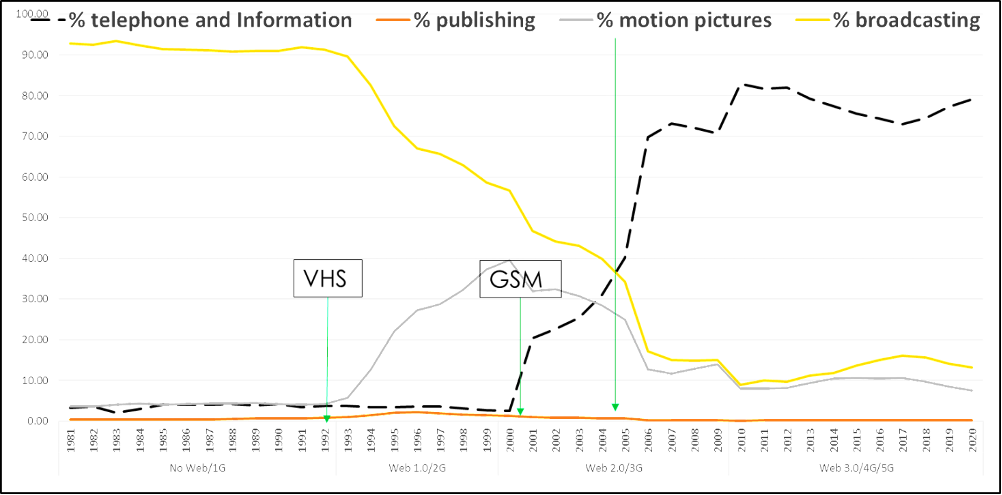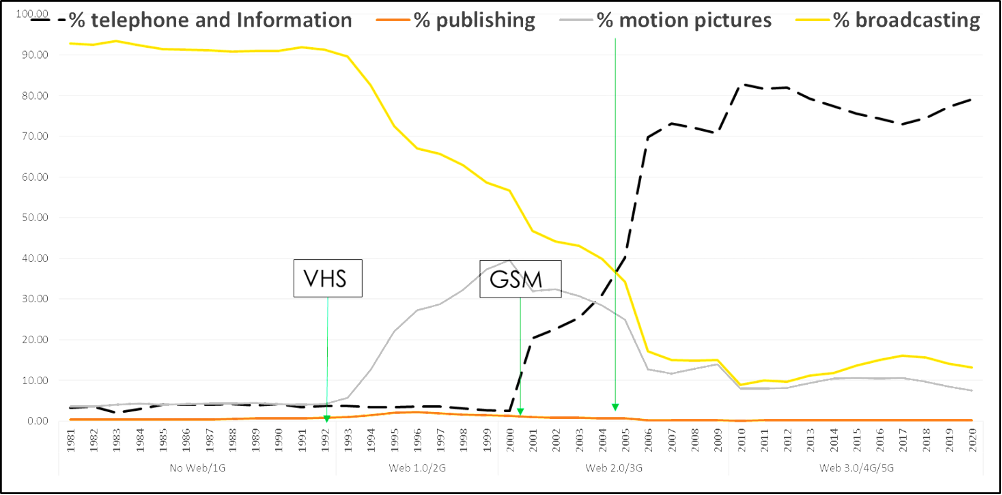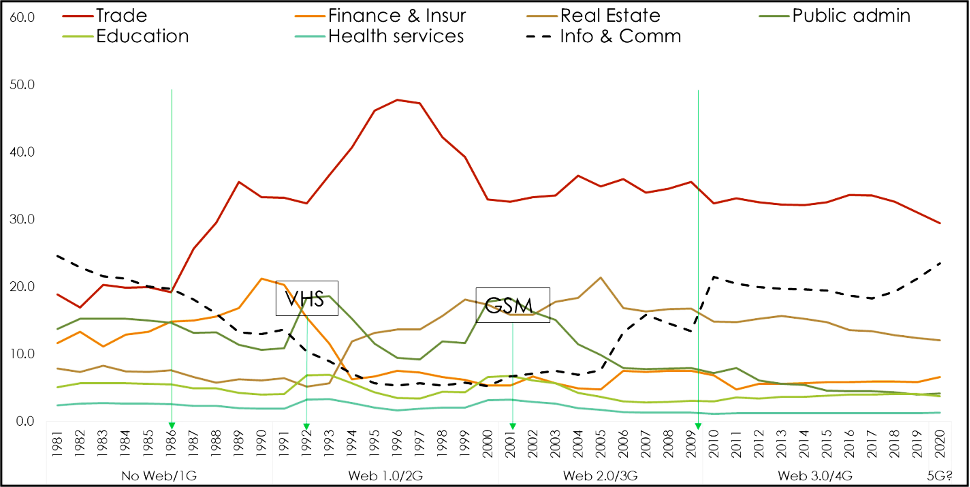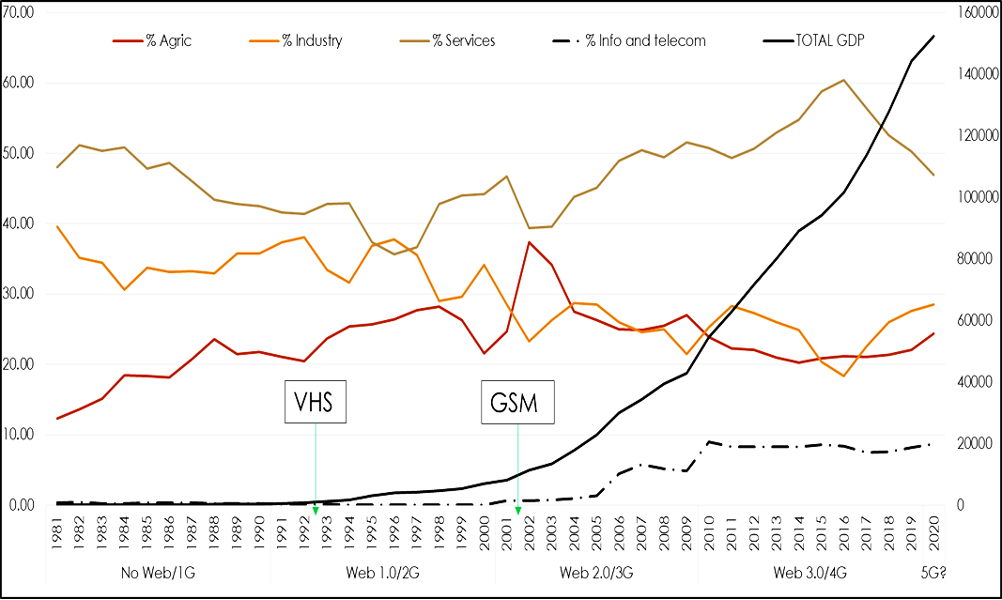Bankole Falade, Ph.D.
Technological innovations and policy liberalisation have led to a massive expansion in telecommunication infrastructure in Nigeria leading to improved access to telephones and the internet and the subsequent expansion of sector contributions to economic growth. The communication industry commenced in Nigeria around 1886 when the first telegraph services connected Lagos with London, the colonial administration. This was followed by radio around 1933 when the Radio Distribution System (RDS) began to broadcast programmes from the British Broadcasting Corporation. Africa’s first television station, the Western Nigerian Television (WNTV) hit the airwaves in 1959. While all three were attributable to innovations in technology, the WNTV was first in Nigeria, and in Africa, due to a change of policy that removed television broadcasting from the exclusivity of the federal government and allowed regional administrations: Western, Northern, and Eastern Regions to take the initiative.
This article compares two periods in the telecommunication industry: pre and post-liberalization. Pre-liberalisation (1981 – 2000) was one of the government monopolies of the telephone industry with a national carrier and fixed lines while the post-liberalisation (2001 – 2020) saw the spectrum auction of digital mobile licences to the private sector. By the year 2000, the installed capacity was 400,000 telephone lines, there are now close to 195 million active phone lines for a population of about the same number, and not only can you make voice calls, but you can also see the caller and engage in a series of social and commercial interactions with internet-enabled phones and broadband. The article examines the growth in the contributions of telephone and Information services within the information and telecommunication sub-sector and the growth of the telephone services and the services sector within the wider economy.
Information and telecommunication services
The information and telecommunication services subsector comprises four units in the Gross Domestic Products calculations: telephone and information, publishing, motion pictures, and broadcasting. Each has its own policy history and innovation-induced growth.
Motion pictures
While the movie industry in Nigeria, called Nollywood, can be traced to 1962 with a remarkable production period in the ’70s and ’80s, it was technological innovation, which introduced a much cheaper alternative to celluloid, the Video Home System (VHS), that significantly transformed the industry. Prior to the advent of the VHS, the Nigerian movie industry was stymied by the very expensive celluloid movie production system, resulting in very low output. Since 1992, when the first movie using the VHS was produced, it has climbed to second place worldwide, after Bollywood, the Indian movie industry, in terms of volume of production.
Broadcasting (Radio and Television)
Following a change of policy which led to the emergence of WNTV as Africa’s first television station, competition among the regions led others to quickly establish their own stations and by 1962, the Eastern Nigeria Broadcasting Service and the Broadcasting Corporation of Northern Nigeria came on the air. The centralisation of broadcasting by the military led to the takeover of regional television and radio stations and the formation of the Nigeria Television Authority in 1977 and the Federal Radio Corporation of Nigeria in 1978. Policy reversal in 1992 led to the deregulation of the industry effectively ending the monopoly enjoyed by stations owned by the Federal and State Governments and the emergence of privately owned radio and television stations, albeit with limited coverage areas. Post-liberalisation, there are about 260 radio stations and over 100 television stations with a fast-growing digital radio and TV component. While the NTA and FRCN are the only organisations allowed to broadcast nationwide, technological innovations have allowed these “local” radio and TV stations to broadcast all over the world.
Publishing (newspapers)
The first Nigerian newspaper can be traced to 1859 with the publication of Iwe Iroyin. It has since grown from circulating among the Yoruba-speaking population of the South-West to nationwide coverage with significant expansions in the run-up to independence. Largely private initiatives, centralisation by the military, purely to control editorial direction, led to the partial acquisition in 1975 of two prominent newspapers, Daily Times, which largely served the southern part of the country, and the New Nigerian Newspaper which its Northern focus, and eventually full control in 1977. The acquisition policy was later reversed, and the newspapers returned to private ownership. Technological innovations outside the industry (computers, digital cameras, internet, broadband) have had a significant impact on how news is gathered, processed, and published, both in form and content. While the circulation of hard copies has declined significantly, the internet has boosted online reading and news is now on demand.
Telephone and information
In 1960 there were about 19,000 telephone lines for a population of about 50 million and the Nigerian Telecommunications Limited (NITEL) was formed in 1985 with the merger of the telecommunications division of Post and Telecommunications (P & T) and Nigeria External Telecommunication (NET). P & T previously handled internal mail and telecommunication while NET oversaw external communications, both inheritors of the telegraph services which commence operations in 1885. NITEL was created as a government-owned monopoly operator to provide a range of services such as Fixed Telephone, Telegraph, and Payphone. By the year 2000, the installed capacity had improved to 400,000 lines but was far below expectations. Notably, the analog cellular service was introduced almost simultaneously in the mid-eighties in South Africa and Nigeria, but while Nigeria could only boast of just about 25,000 lines by the beginning of the year 2000, with services covering less than 20% of the country’s geographical area, South Africa already had two major digital mobile operators with a total installed capacity of about 3 million lines covering over 80% of the country. Policy changes that liberalised the sector began in 1992 with the Nigerian Telecommunications Act but this did not achieve desired increase in telephone lines as the National Carrier retained the monopoly of fixed wireless, long-distance transmission, and the International Gateway. A new National Telecommunications Policy was released in September 2000 and in 2001, the country auctioned Digital Mobile Licences for US$285m each to MTN, ECONET Wireless, and MTel/NITEL. This period coincided with increasing technological advancement with the introduction of the 2nd Generation wireless cellular mobile networks which allowed voice calls and limited data transmission, replacing the analog 1G which allowed an only voice. Also, in the same year, other telephone companies: Multilinks, Intercellular, Reltel, Starcomms, and Mobitel launched commercial services based on CDMA technology. The next two decades saw significant advances as mobile technology moved from 2G to 2.5G, and 2.75G to 3G, allowing more data, video, and internet access. The much faster 4G was released about 2009.
Telephone and information infrastructure thus expanded rapidly in numbers, types and geographic spread in Nigeria encouraged by policy and technological innovations. Thus, by end of September 2011, Nigeria’s active GSM subscriber base was at 93.5 million and this increased astronomically to 195 million active subscribers of the 304 million connected to the networks in 2021. Other services include 106,000 active fixed wireless lines from 218,354 subscribers and 230,000 VoIP active lines from 1.1million subscribers. There are thus about 305 million connected lines for a population estimated at 190million. Also in 2021, there were 142million Mobile GSM internet subscribers; 12, 000 on fixed wires; 343,000 on VoIP, and 78 million on various broadband subscriptions (data from the Nigeria Communications Commission).
Policy changes, innovations, information and telecommunication infrastructure
Innovations in communication infrastructure significantly reduced the cost of making movies in Nigeria propelling the industry to new heights and spreading its impact all over the world. Policy changes in the broadcasting industry led to the emergence of private television and radio stations and technological innovations have allowed them to broadcast beyond their restricted local licences to viewers all over the country and beyond and on multiple devices. Communication infrastructure innovations also transformed the process of publishing news and expanded its reach far beyond the country. Perhaps the greatest transformation is in telecommunications where wireless signals now cover almost the entire country and handheld devices are affordable to almost every intended user. Movies, news, television, and radio can now be viewed on the same equipment and the same news medium can now offer all three hitherto separate forms of a news broadcast: print, radio, and television, on the same platform.
Innovations in computing technology, mobile cellular technology (1G to 5G), and broadband access have significantly transformed other sectors of the economy as well. Apart from transforming the information and communication section covering publishing, motion pictures and broadcasting, communication infrastructure, and innovations have become the driving tools of growth in the services sector comprising Trade, Finance & Insurance, Real Estate, Public Admin, Education, and health services. Through its significantly improved communications functions and adaptability, it has also been deployed widely in agriculture and industry. The International Institute of Tropical Agriculture for example has developed a hand-held mobile app called ‘Nuru’ that uses artificial intelligence to accurately diagnose crop diseases on the field.
Pre and post liberalisation: policy changes and reversals
1981 to 1999 was a period of government monopoly and centralisation of regulations, central planning, unified products and services, and low technology infrastructure and innovation products in the industry while the period 1999 to 2020 was of policy reversals, decentralisation, privatisation, multiple products and services and an explosion in communication infrastructure and innovation. In the first period, there was very high demand for telephone, but supply was low and cost, where available was prohibitive. In the second period, a combination of policy changes and innovation in technology rapidly increased supply and lowered acquisition costs and as innovation continued to boost access and uses, demand continued to increase as well as supply and coverage. The first period was when telephone and associated services were “not for the poor” and the second was when telecommunication infrastructure and allied products were “for everyone”.
 Figure 1 Contributions to Information and telecommunication services (data from the National Bureau of Statistics)
Figure 1 Contributions to Information and telecommunication services (data from the National Bureau of Statistics)
Figure 1 shows that at the beginning of the first period, broadcasting was the lead contributor to information and telecommunication services and the gap was very wide compared with the other three: publishing, motion pictures, and telephone and information. The VHS innovation in 1992 was followed by a steady rise in the contribution of motion pictures and a decline in the share of broadcasting at about the same time. This was the beginning of the era of Nollywood. The 2001 introduction of the 2nd Generation wireless cellular mobile networks heralded a decline in the contribution of motion pictures and a further decline in broadcasting with a sharp rise in telephone and information.
The rise in the contribution of the telephone continued and overtook motion pictures in 2004 and broadcasting in 2005 and continued to rise while they declined. By 2019 the position of the telephone as the leading contributor was incontrovertible with the gap between it and others replicating the gap in the 1980s between broadcasting and the others. The contribution of publishing remained largely unchanged throughout both periods with a noticeable bump in the mid to late 1990s.


Figure 2 Contributions of Information and telecommunication to services sub-sector (data from the National Bureau of Statistics).
Within the services subsector (Figure 2), information and communication was in a decline at the beginning of the study period but was the largest contributor till 1986, overtaken by Trade around 1987. Trade’s contribution saw a steep rise to a plateau of 48% of GDP in 1996 only to crash to 33% in 2000. Information and communication continued to decline and bottomed out in 2000, having been overtaken by real estate, public administration, finance, and insurance to the 5th position of seven in the section. It began to rise again in 2001 with the introduction of the 2nd Generation wireless cellular mobile networks and back to the second position around 2010. Trading was flat between 2000 and 2016 with a noticeable downward trend dipping below 31% of GDP by 2019. If the trend continues, information and communication may return to the number one position it held in the early 80s before it was overtaken by trade.

Figure 3 Contribution of Information and telecommunication, Agriculture, industry, and services sector and GDP growth rate (data from the National Bureau of Statistics).
Between 1981 and 1993, growth in Nigeria’s GDP was slow as Figure 3 shows. Signs of improvement commenced in 1994 with a steady rise to 2020 followed by an exponential increase. The percentage contribution of information and telecommunication was also low and flat, till a rise from 2001 to 2005, followed by further rises from 2005 till 2010 from when its contribution has remained steady, just shy of 10%. The services sector contributed about half of GDP between 1981 and 1985 when it commenced a fall till it bottomed out at about 36% in 1996 before rising again and although it experienced a sharp drop in 2002, it regained momentum to peak at above 60% in 2016 before declining to low 47% by 2020. Covid-19 hit the world in late 2019 and was first isolated in Nigeria in early 2020 so the decline preceded the pandemic. The decline in services contribution was due largely to increases in agriculture between 1981 and 1988, an increase that peaked at 37% in 2002, putting it second to services’ 39%. The manufacturing industry maintained an equilibrium between 30 and 40% till a sharp drop in 1998 from which it recovered only to dip again in the year 2002. A surge in 2003 did not return to previous heights and by 2004, both manufacturing and agriculture fluctuated between 20 and 30%.
Policy, tech innovation, and economic growth
Wired telephone lines have been credited by academics with propelling industrial growth due to savings in time, cost, and energy in communication between and within firms and access to information for research and development of new and better production systems, products, and markets. This has increased exponentially with the introduction of internet-enabled phones and broadband services. But is the contribution attributable to technology innovation alone? What’s the role of policy, pre, and post-innovation in telecommunication infrastructure?
The article has shown the combined effect of policy changes and technology innovation on economic growth in Nigeria. The results are fascinating for a country that hardly manufactures any of the components used in telecommunication infrastructure. A visit to the computer village in Ikeja Lagos (and other communication-focused markets in the country) shows our adoption is the trading side: buying, selling, and minor repairs. Some local entrepreneurs have invested in the industry, but their products are manufactured mainly in China and imported for local consumption.
The effect of telecom infrastructure innovation is obvious in trading but also extensive in commerce, industry, and agriculture. The covid-19 pandemic and the restrictions imposed on the movement of workers forced many to work from home and it’s better imagined if the internet was not available for the thousands of online meetings that took place daily across the country. You can now from the comfort of your home monitor an entire production process as advanced robotics become integrated with advances in broadband capacity. Online trading also means you can also order goods from the comfort of your home.
Direction of causality
This article is exploratory and does not measure the direction of causality. It focuses on percentage contributions and their increases over time. But is the debate over the direction of causality between communication infrastructure and economic growth still necessary given the widely acknowledged contributions of mobile phones, internet, and broadband to commerce, industry, and agriculture and the significant effect on the structure of GDP?
The position of economists in the past is that where the state of the telephone system is rudimentary, communications between firms are limited thus transaction costs of ordering, gathering information, and searching for services are high and as the telephone system improves, the costs of doing business fall, and output will increase for individual firms in all sectors of the economy. Some researchers argue for a unidirectional causality running from telecommunications investment to economic development which implies that reducing telecommunications investment could lead to a fall in income while for an opposite unidirectional causality, policies aimed at stimulating the economy by accelerating investment in the telecommunications sector may not be successful. For a bi-directional causality, policies aimed at stimulating investment in telecommunications infrastructure can induce economic growth while economic growth, in turn, can stimulate the growth of telecommunications activity and if there is no causality in any direction, increasing or reducing telecommunications infrastructure may or may not have any positive or negative effect on economic growth, and economic growth may or may not stimulate the demand for telecommunications infrastructure. Reverse causality implies that one needs to distinguish two effects: the increase in economic growth, which is attributable to increases in telecommunications infrastructure, and the increase in the demand for telecommunication services, which is attributable to increases in economic growth. Most of the research in the field was from data before the transformative power of 2, 3G and 4G became manifest in both personal and business communications.
Examining China and its regions between 1978 and 2004, researchers Alice Shiu and Pun-Lee Lam in a 2007 research article argue that there is a unidirectional relationship running from the real gross domestic product (GDP) to telecommunications development at the national level and this causality was found only in the provinces in the affluent eastern region, but not in the low-income central and western provinces. The results, they argue, imply that an improvement in telecommunications infrastructure alone is not sufficient for stimulating growth in the central and western provinces noting the need to develop and enhance other complementary factors like business environments, transportation networks, education, and manpower.
Policies and advances in telecommunication infrastructure have contributed significantly to economic growth in Nigeria but as we bask in the euphoria of internet-enabled advances, what is the implication of the Chinese scenario for Nigeria? Is what we see with the national figures a distortion, caused by averages, which hides the disparities between commercial cities and rural areas, between affluent states and less endowed states? How do we adapt advances in telecommunication infrastructure as a stimulus to improve rural economies and reduce rural-urban drift? What are the implications of the continuing expansion of telecommunication infrastructure for the country’s long-term economic goals if this improvement is not matched by policy changes that stimulate business environments, education, and manpower needs in less developed cities and rural communities?
Bankole Falade, Ph.D. is a Visiting Fellow, Department of Psychological and Behavioural Science, London School of Economics and Political Science, London, United Kingdom. The format of this paper was presented at the 72nd Annual International Communication Association Conference held in France, in 2022.






















